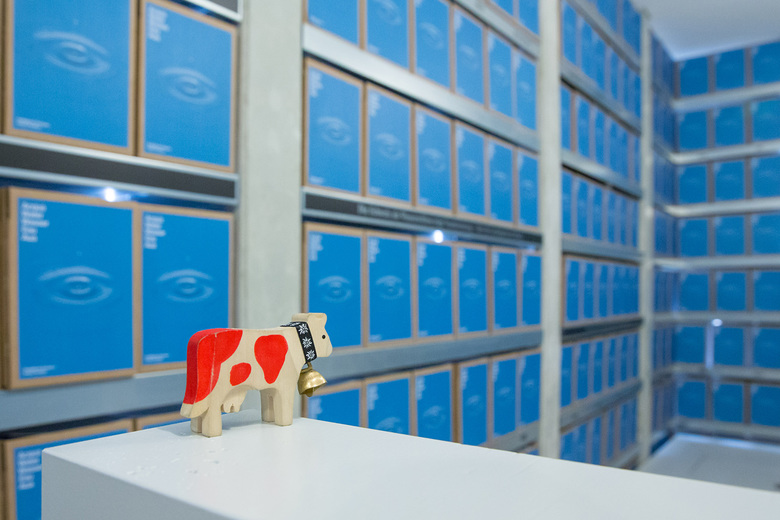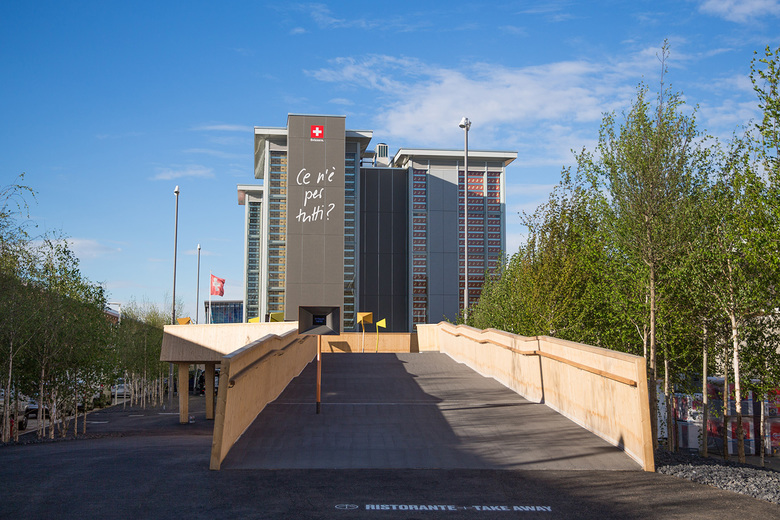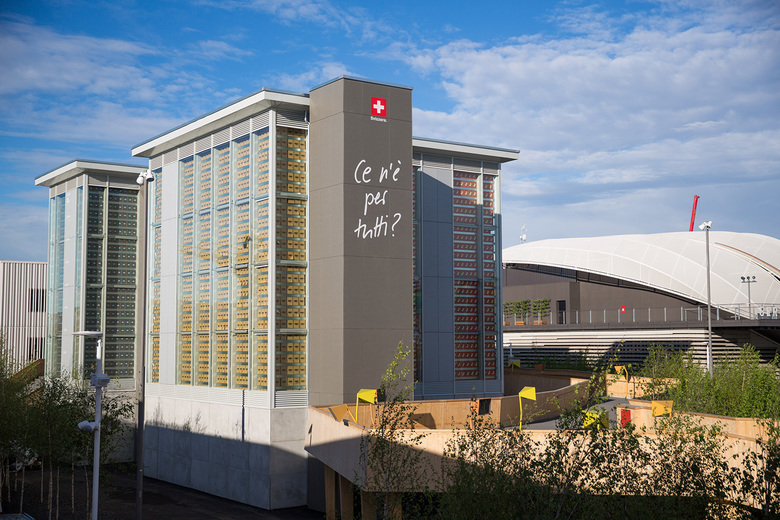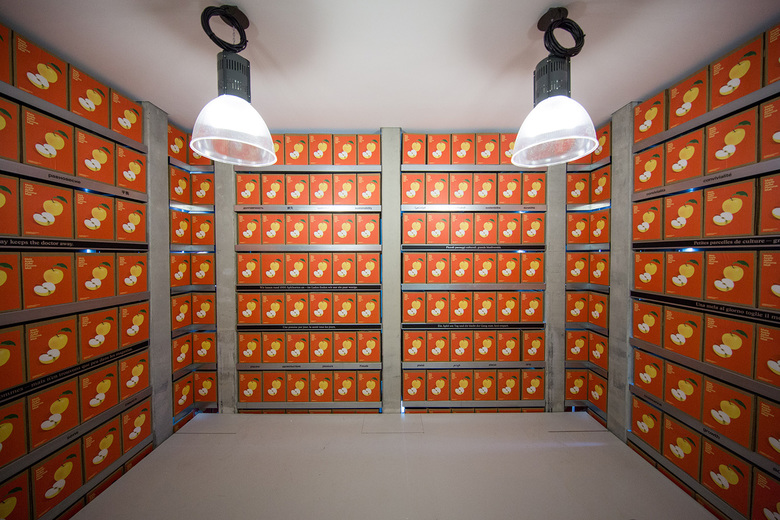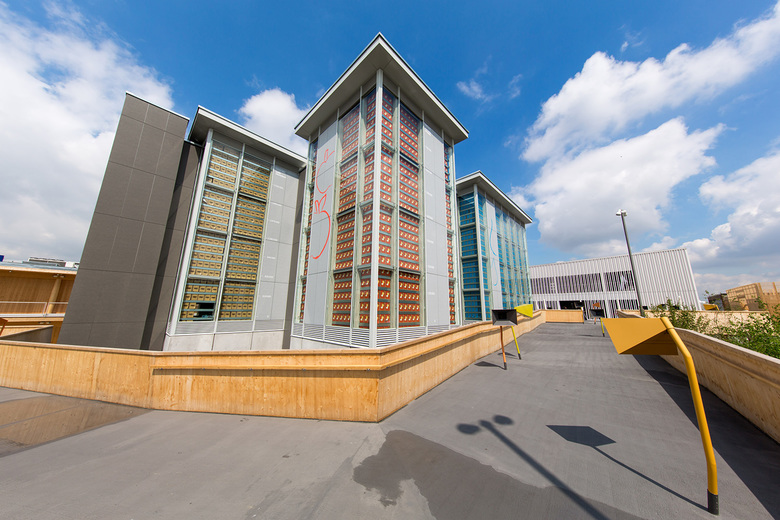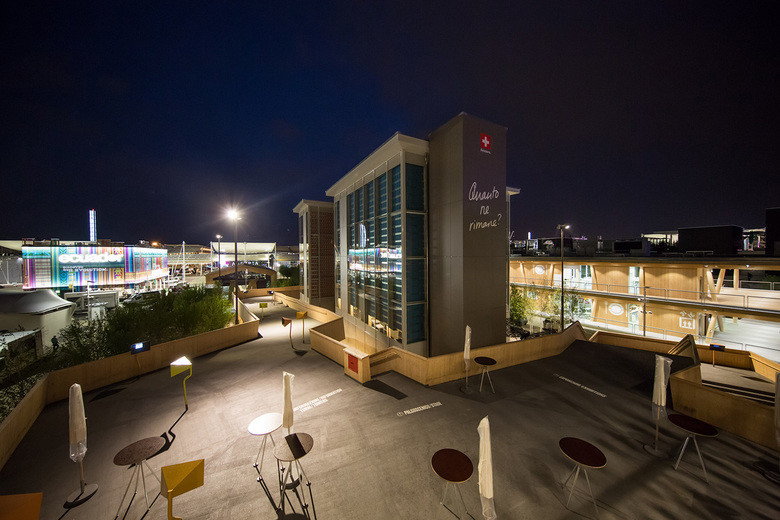Swiss Pavilion at Expo Milano 2015
Fred Bernstein
14. May 2015
All photographs are courtesy of Swiss Pavilion
“Welcome to the world’s most equitable supermarket,” says a young man trained to greet guests in several languages. This supermarket is the centerpiece of the Swiss pavilion at the World Expo 2015 in Milan — where countries were asked to explore the theme “Feeding the Planet, Energy for Life.”
In keeping with that theme, the Swiss Pavilion aims to teach a lesson about shortages and waste.
Facing the main thoroughfare of the Expo, it is divided into four right-angled towers made of glass. Each tower (by architects Netwerch GmbH Brugg) is stocked with boxes – in the first, the boxes contain small packets of ground coffee; in the second the boxes contain small packets of salt; in the third, plastic packets of dried apples, which can be eaten on the spot; and in the fourth, plastic cups meant to be filled with water. In that silo, tap water is dispensed from a spigot with an LED readout indicating how much potable water remains. (On the afternoon of opening day, it was 95,947 liters out of 96,000.) The idea, the host explains, is that visitors to the pavilion can take as much salt, water, coffee, and dried apples as they like. The only problem, he warns, is that if you take too much, there won’t be any left for people who come later to the fair, which runs until October 30. Greed will lead to shortages, the notion goes.
The idea isn’t just stated. The big gimmick of the pavilion is that it is demonstrated through architecture. As the stock in each silo diminishes, the floor on which visitors walk through that silo is lowered. Accordingly, it will be possible for visitors later in the six-month run of the fair to reach shelves lower in the building, and for passers-by to see the empty shelves in the upper reaches of the glass-walled silos. If that isn’t enough of an engineering feat, the elevators, by Schindler, had to be set to deliver visitors at different points as the floor levels change. It will be interesting to see the pavilion later this summer, when the top shelves are empty, and the floors are closer to the ground.
But the idea isn’t executed in a way that makes sense. First, there is no reason to take single-serve packets of coffee or tiny packets of salt. (Who's going to carry salt around an Expo?) More importantly, there is no indication (minus the water meter) of how much of each foodstuff is in stock, and how many people are expected to pass through the pavilion during its six-month run. Therefore, there is no way for visitors to calculate their "fair" allotment. Another quibble: because people can't reach the highest shelves in each room, organizers will have to rearrange boxes during the night to achieve anything like the visual effect — a clear indication of dwindling resources — they’re hoping for. And from the outside, the silos, gray and boxy, are anything but enticing.
Then, too, the water is served in thick plastic “souvenir” cups, which visitors are asked to take with them. Why the waste of thousands of plastic cups (some 400,000, at four cups to a liter) in a pavilion devoted to sustainability? Paper cups would have been less wasteful; a water fountain without cups, less wasteful still. And plastic jugs, while more polluting in one sense, would have allowed people to take as much water with them as they desired, helping the pavilion make its point. (A spokesman for the pavilion pointed out that the cups bear an environmental slogan — “My water is your water, your water is my water” — and can be reused at fountains throughout the Expo.)
The rest of the pavilion consists of three exhibitions entered through ground floor entrances that look like service doors. The first is an excellent treatment of the cultural history of Basel; packed with information, it is unfortunately confined to narrow rooms that aren’t inviting. (Exhibitions on Geneva and Zurich will be mounted in the same space later in the run of the Expo.) The second, sponsored by Nestle, the pavilion’s largest donor, is an attempt to sell the company’s image by making obvious points (“good nutrition improves health”), except the obvious points are rendered unobvious through the use of overly complicated interactive technology.
The third exhibition is the best and worst of the pavilion. Best because it focuses on the collection of water in the Alps and centers around an absolutely stunning, 21-ton granite model of thousands of square miles (at a 1:25000 scale) of the San Gottardo massif. Water drips into the model from sluices suspended from the ceiling, and then runs out through rivers in the pavilion floor. The model is so beautiful it should have been the centerpiece of the pavilion. But worst because the copious wall text around the model, which is a celebration of the massif’s role in providing water for much of Europe, never mentions global warming and the shrinking of the Alpine glaciers. The failure to say even one word about this terrifying reality renders the exhibition more decorative than informative.
Fred Bernstein is a writer based in New York City.
